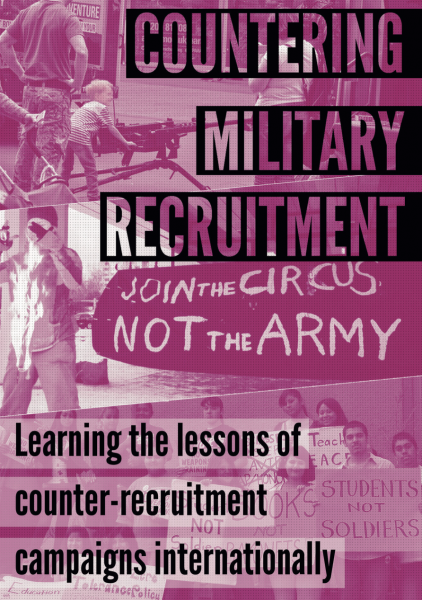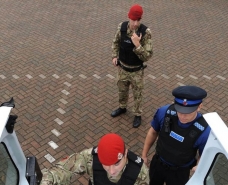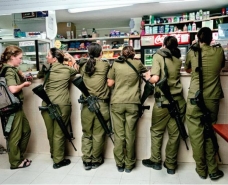The impact of internal conflict and the para-state in Colombia

Jorge Vélez
Today in Colombia, it is mostly young men who are sent to fight in the civil war that rages in the most impoverished and vulnerable cities and countryside and which continues to cause widespread deaths and destruction of the land. Sadly, it is a conflict between people who share the same social and economic background. Far right-wing oligarchs perpetuate the war and block dialogue between the parties in conflict. They do this because they are very scared of losing the only enemy that has justified their anti-populist reforms, actions and attacks. In order to understand how this parlous state of affairs has come about and to talk about the militarisation of the country – and in particular its youth - it is necessary to look at its history.
1948 and the conservative strategy of stigmatisation and persecution
The current war in Colombia dates back to 1948, when the presidential candidate Jorge Eliecer Gaitán was murdered and the possibility that socialist ideas would gain a foothold was crushed. Between 1948 and 1953, approximately 300,000 Colombian men and women were murdered in confrontations between the political right and left, in the period known as ‘La violencia’ (The Violence). It should be made clear that even before this, Liberals and Conservatives had murdered each other in their thousands – there were 14,000 violent deaths in 1947[2], which Gaitán himself condemned in his 1948 speech ‘La oración de la paz’ (The prayer of peace).
FARC: Origins of the insurgency
FARC (The Revolutionary Armed Forces of Colombia) came into being with the transformation of the Liberal and communist peasant self defence force into structured guerrilla units whose aim was to get into power. The bombardment carried out by the government against a group of peasants in Marquetalia on 27 May 1964 inevitably transformed the conflict that had already been going on between the Colombian state and the armed peasants in the south of Tolima, following the disbandments and amnesties carried out by dictator General Gustavo Rojas Pinilla in 1953. Forty-eight fighters resisted the attacks of that bombardment.[3] Later, 'the self-defence unit became mobile guerrillas through the creation of the so-called Southern Front in 1964. Two years later, it became the Revolutionary Armed Forces of Colombia (FARC)'.[4]
For FARC, the political and military project remains: it is faced with a context of inequality, persecution and pillage which led to its creation in the 60s. However, the current political, military and social situation in Colombia resulting from the damage caused by the war - so long and destructive that it has dampened any hopes for change through military means - requires a negotiated exit.
The state strategy of working with right-wing paramilitaries in defence of political and economic privileges
The origin of the armed forces of the extreme right dates back to the middle of the twentieth century, with the chulavita and pajaros 'police'[5] - private gangs formed from armed police units and supported by the state, who murdered 'liberal peasants in several of the country’s rural regions'.[6] Key developments in the subsequent history of state-supported paramilitarism include: the 1968 Law 48, which authorised the supply of weapons to civilians to fight against the insurgency; the training provided by the US military in creating private anti-terrorist and anti-communist armed groups in the 1970s; the 1981 creation of 'Death to Kidnappers' (MAS) by drug traffickers and the Colombian military, and of 'social cleansing' groups - like the Twelve Apostles in Yarumal, Antioquia - at the end of that decade; the formal founding of the right-wing United Self-Defence Forces of Colombia (AUC) in 1997; the Pact of Ralito signed in 2001 by the main paramilitary bosses and recognised by the different political factions; funding of Álvaro Uribe Vélez’s campaign for the presidency in 2002 by paramilitary groups; the removal of FARC by the armed forces, police, and AUC from Medellín in Operation Orion in October 2002; and President Álvaro Uribe Vélez's (2002-10) creation of the Network of Volunteers, which was joined by disbanded paramilitaries. All of these groups and initiatives were created in order to defend the privileges of the liberal and conservative oligarch class of landowners and aristocrats. As the politician Gustavo Petro commented in the debate on the origins of paramilitarism in Antioquia: 'paramilitarism didn’t arise because the State didn’t exist – it arose alongside sectors of the State'.
War in figures: Investment in Defence and Security, and the size of the various armed forces
The state investment in defence and security – activities and services of National Defence - was 9.954 trillion pesos in 2012, and in Public Order and Citizen Security was 9.759 trillion; both equating to 3% of GDP. In comparison, 2% of GDP was spent on healthcare, 2.9% on education, and 0.3% on housing.[7] It is estimated that funding for guerrilla operations in 2004 were 1.697 trillion pesos for FARC and 743 billion pesos for the National Liberation Army (ELN).[8]
In 2010 the Colombian Army, Air Force and Navy had 284,724 personnel, and the armed National Police had 153,231 officers. As for guerrillas, according to state figures FARC has between 8,500 and 9,000 members, and ELN has between 2,000 and 2,200. There are no accurate figures for the right-wing paramilitaries, though nearly 32,000 members were disbanded after 2003, many remaining active but referred to by the state as BACRIM (criminal bands) to give the impression in public and official discourse that paramilitarism had been dismantled. According to one estimate these bands comprised between 7,100 and 14,500 members in 2010 (depending on whether support networks are included).[9] Attacks against defenders of human rights diminished from 2004 to 2007 - coinciding with the disbanding process -and significantly increased from 2008 'which would seem to be a response to the creation and expansion of criminal gangs spawned from paramilitarism'.[10]
The current situation: fear, violence and armed social control in Medellín
The ongoing social and armed conflict in Colombia intensifies and radicalises militarisation, in terms of the level of violence, the way the media portrays it, and the heavy recruitment – particularly of poor young men - by both sides.
In Medellín and Antioquia, the forced recruitment by the state Armed Forces in public transport stations and at public events attended by large numbers of young people, brings into question the role of young people in these places. Slogans associated with official institutions, such as ‘Medellín: a home for life’ and ‘Antioquia: the most educated region’, contrast starkly with their impoverished political and social reality.
In Medellín CONVIVIR ('Special vigilance and private security services' – a network of anti-guerilla neighbourhood watch groups) and paramilitary groups - offer, by means of extortion, private security services - mainly in areas where there are businesses, massage parlours, night clubs, bars and other places where sexual exploitation and drug dealing occur. Indeed, many of these places are under the management of these paramilitary groups.[11]
Furthermore, an issue that has been neglected by the state and the justice system (apart from sporadic references in declarations of the law of justice and peace), and which has been ignored by the media, is sexual violence against women as a weapon of war.[12] Although since sexism and chauvinism can of course exist under an oppressive system such as patriarchy independently of war, rape and physical abuse against women and girls during the armed conflict have been a systematic and premeditated way of exercising control and fear in communities.[13] These assaults have mainly been carried out by paramilitaries.[14]
The high rate of femicide in Antioquia, substantiates this conclusion. In 2011, 270 women were murdered in Antioquia (119 of them in Medellín). Research is needed as to whether these figures correlate with the return of men from disbanded paramilitaries.
Conclusion
Colombia is a country which is impoverished, militarised and highly influenced by right-wing ideals. More than 15.2 million people are living in poverty, 4.7 million of them in abject poverty.[15] The structural and cultural causes of the armed social conflict are ignored. Military institutions interfere intensely in communities’ social lives, and this affects young people the most: in addition to the large number of forced recruitments, the Civic Youth Police (made up of boys and girls of seven to eighteen years of age) is growing in the country’s main cities, where paramilitary organisations control large areas.
Notes
[1] 'Para-state' refers to entities that purport to exercise state-like authority in a particular territory.
[2] Ricardo Arias, 'Los sucesos del 9 de abril de 1948 como legitimadores de la violencia oficial', Biblioteca Luis Ángel Arango del Banco de la República. http://www.banrepcultural.org/blaavirtual/revistas/rhcritica/arias.htm (accessed September 2012).
[3] Ariel Sánchez Meertens and Gonzalo Sánchez, 'Mayo 27 de 1964: El huevo de la serpiente', Semana, 2008. http://www.semana.com/wf_ImprimirArticulo.aspx?IdArt=78976 (accessed September 2012).
[4] Eduardo Pizarro Leongómez, 'Marquetalia: el mito fundacional de las FARC', UNP, 57 (2004). [Online at http://historico.unperiodico.unal.edu.co/Ediciones/57/03.htm (accessed October 2012).
[5] Daniel Cristancho, 'Entre pájaros y chulavitas: Relato de la tradición oral campesina sobre el conflicto político, social y armado de Colombia', Agencia Prensa Rural, 2011. http://prensarural.org/spip/spip.php?article5176 (accessed September 2012).
[6] Camilo García, 'Lo sagrado y la violencia. Raíces de la violencia actual en Colombia',
Revista Numero. http://www.revistanumero.com/38sagra.htm (accessed October 2012).
[7] Asamblea Permanente de la Sociedad Civil por la Paz, 'Costos y efectos de la guerra en Colombia', 2011. http://alfresco.uclouvain.be/alfresco/d/d/workspace/SpacesStore/c54acc30... (accessed September 2012), p. 14.
[8] Ibid, p. 16. Both figures rounded to the nearest billion.
[9] Ibid, p. 25.
[10] VerdadAbierta.com, 'Paramilitarismo y conflicto armado en Colombia. Paramilitares continúan atacando a defensores de Derechos Humanos', 2011. http://verdadabierta.com/bandera/index.php?option=com_content&id=3901 (accessed September 2012).
[11] Elmundo.com, 'Convivir, la seguridad en manos de los ilegales', 2012. http://www.elmundo.com/portal/movil.detalle.php?idx=178431 (accessed September 2012).
[12] VerdadAbierta.com, 'Paramilitarismo y conflicto armado en Colombia. Batallas de hombres en cuerpos de mujeres', 2009. http://www.verdadabierta.com/nunca-mas/41-violencia-contra-mujeres/801-b... (accessed September 2012).
[13] Ibid.
[14] Lapluma.net, 'IV Semana por la Memoria: Mujeres y Guerra. Víctimas y resistentes en el Caribe colombiano', 2011. http://www.es.lapluma.net/index.php?option=com_content&view=article&id=2... (accessed 31 May 2013).
[15] Elespectador.com, 'Pobreza en Colombia afectó al 34,1% de la población en 2011', 2012. http://www.elespectador.com/economia/articulo-346885-pobreza-colombia-af... (accessed September 2012).
Translated from the original Spanish by Rebecca House
Source: http://www.wri-irg.org
Countering Military Recruitment

WRI's new booklet, Countering Military Recruitment: Learning the lessons of counter-recruitment campaigns internationally, is out now. The booklet includes examples of campaigning against youth militarisation across different countries with the contribution of grassroot activists.
You can order a paperback version here.








